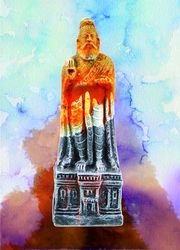Much of the south has held out against the BJP, but none more so than Tamil Nadu. Desperate to provoke a breakthrough, the BJP has resorted to its favourite trick of appropriating the icons of others (such as Sardar Vallabhbhai Patel) to give itself a pedigree that it otherwise lacks. In Tamil Nadu, this has taken the form of a BJP tweet that dresses Thiruvalluvar, the greatest moral mentor of the Tamil people and symbol of its syncretic heritage, in a saffron robe. Thiruvalluvar has traditionally been depicted in pure white.
Scholars, stretching from the 13th century renowned commentator Parimezhalagar to the present, have found evidence of not merely Vedic influences on the 1,330 verses of the saint-poet-philosopher’s famed Thirukkural, but also so strong an imprint of Jainism that many consider him a Jain rather than a Hindu. Besides, the Buddhist impact on his thinking and verses is so evident that there are those who take him to be a Buddhist. Indeed, the Sermon on the Mount seems to have left such a major footprint on the saint’s worldview that one school of thought believes he was profoundly moved by the preachings of the Apostle, Saint Thomas. Why, even among Hindus, there are verses that reveal Thiruvalluvar as a Saivite and others that show him a Vaishnavite.
To appropriate such an eclectic thinker as the symbol of hindutva is the kind of molestation of history, culture and belief that the saffron forces keep deploying to attain their narrow partisan ends. As the Dravida Munnetra Kazhagam leader, M.K. Stalin, remarked: “Instead of colouring Thiruvalluvar, they should learn the Thirukkural and reform.” His party spokesman, T.K.S. Elangovan, added: “Yes, saffron denotes a particular religion. Why should he [Thiruvalluvar] be covered in saffron?” The BJP, through its spokesman, Narayanan Thirupathy, stuck, as ever, to interpreting Hinduism in terms of the “other”, stressing that “during his [the sage’s] time, there was no place for Muslims and Christians”. Even T.T.V. Dhinakaran, leader of the breakaway All India Anna Dravida Munnetra Kazhagam (AIADMK) faction, has held that “Thiruvalluvar is above all caste, creed and religion”, while the spokesman of the AIADMK, Kovai Sathyan, despite taking potshots at the rival DMK, has conceded that “You cannot contain his (Thiruvalluvar’s) contribution to one particular religion”. Rajinikanth, of course, topped them all when laughingly he remarked: “Attempts are being made to paint me with the BJP colour as they have tried to do with Thiruvalluvar, but neither Thiruvalluvar nor I will get trapped.”
The avowedly atheistic, anti-Brahmin, anti-Aryan and anti-Hindi proponents of “Dravida Nadu” were persuaded to remain Indian by providing them the constitutional, democratic and electoral space to win the people’s support to come to political power in 1967. It was a power equation forged in the white heat of the agitation that followed the Centre’s attempt to make Hindi the sole official language of India. It is a state where All India Radio’s Hindi news is masked over by Tamil news at the same time. It was but weeks ago that a technical committee’s recommendation that Tamil Nadu be required to switch to a three-language system—that would compulsorily add Hindi to the school curriculum—sparked off an agitation that would have consumed the state, had not the newly re-elected Narendra Modi government beaten a hasty retreat.
To divide such a people, who unanimously adore Thiruvalluvar, by draping him in saffron is irresponsibility of the highest order.
Aiyar is a former Union minister and social commentator.


